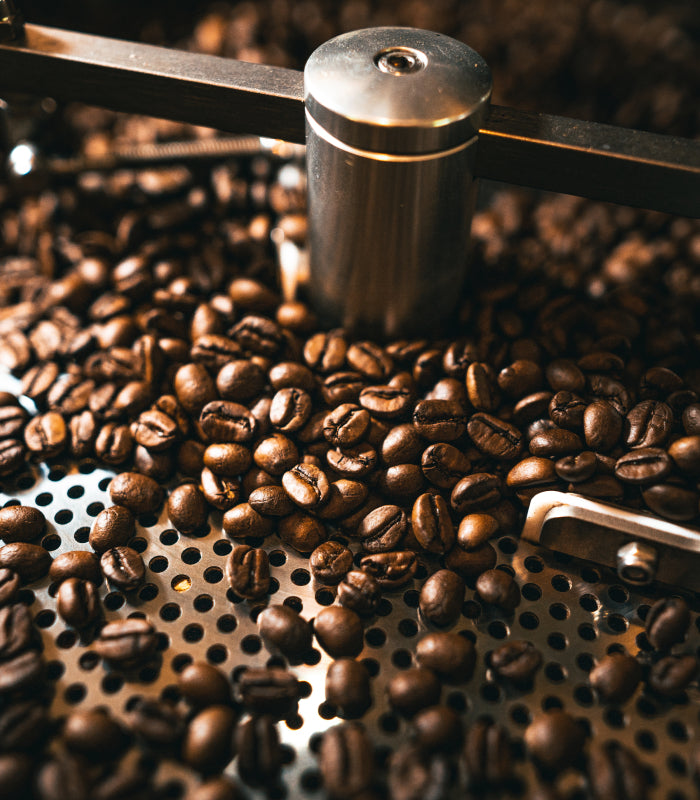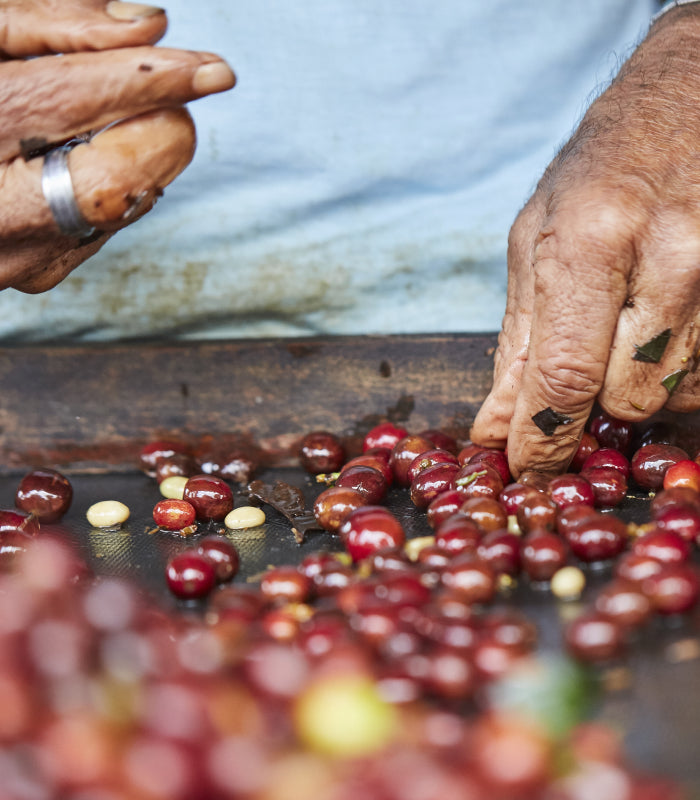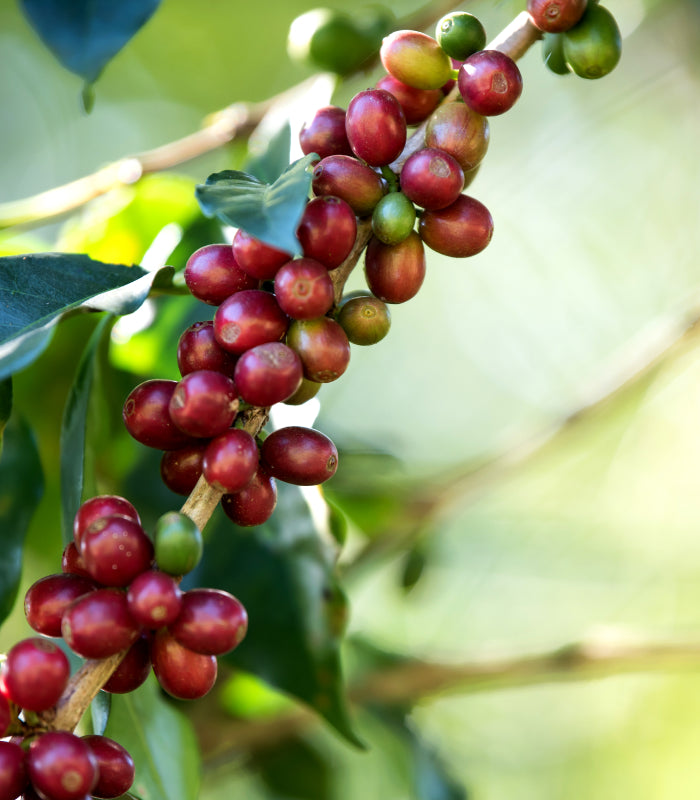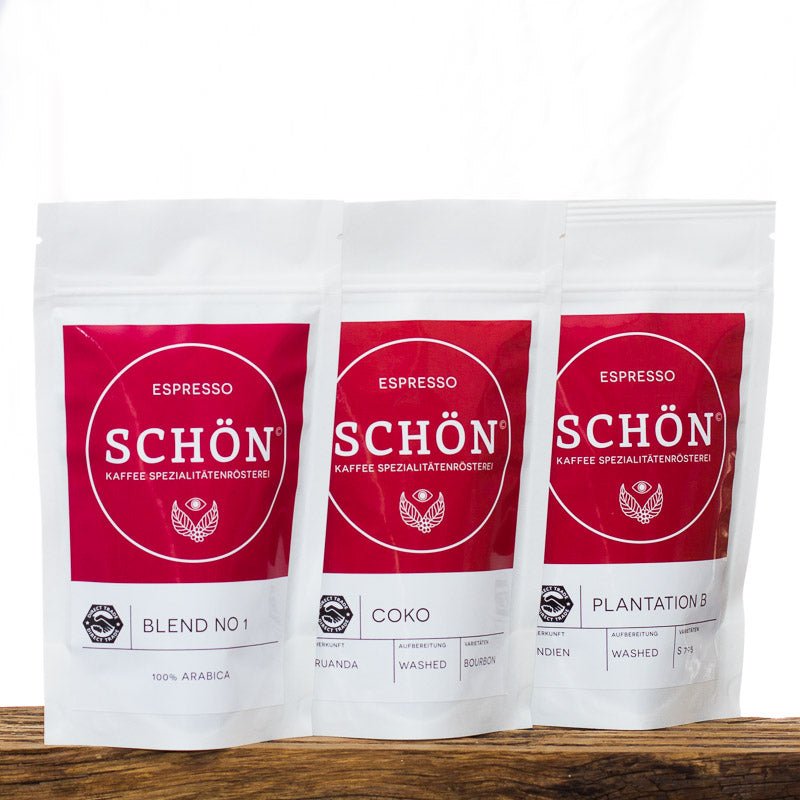Description
Description
roasting
Espresso Roasting
Our espresso roasts are usually roasted darker and slower than our filter or omni roasts. However, this does not always apply to lighter variants, which are roasted more slowly but not necessarily darker. This method breaks down more acids and gives the coffee a fuller body. Although the crema is not a direct quality indicator, lighter roasts are characterized by a lighter and thinner crema that contains natural bitter substances. Ideal for portafilters, stovetop coffee pots and sometimes also for fully automatic machines.
Omni Roast
Our Omni Roast is roasted a little lighter and faster than our espresso roasts, but stays a little darker and slower than our filter roasts. This versatile roast is designed to work great as both a filter coffee and an espresso. The flavor profile leans more towards that of a filter roast, with prominent fruity and sweet notes, but also offers the intensity and body typical of espresso. This balance makes the Omni Roast particularly flexible and ideal for coffee lovers who like to experiment with different preparation methods.
Light roast
The light roast, with a roasting time of 7 to 10 minutes, emphasizes mainly fruity aromas, without dominant roasted aromas. The body can vary from light to medium, with increased acidity often noticeable. This roast is ideal for lovers of light, aromatic coffees.
Medium roast
Our medium roast, roasted for 9 to 11 minutes, offers a balanced blend of light roasted aromas and a prominent balance of body and sweetness. This roast is suitable for medium espresso and is also well suited to fully automatic machines.
Dark roast
With a roasting time of 12 to 14 minutes, our dark roast achieves a deeper degree of roasting. Characteristic here are clear roasted aromas, often with a chocolate undertone, less acidity and more intense bitter substances that promote a stronger crema. Ideal for lovers of classic, strong coffees, but less intense than traditional southern Italian roasts. Also suitable for fully automatic machines.

processing
Washed Process
In the so-called washed process (or wet processing), the coffee cherries are thoroughly washed after harvesting and sorted by size through various sorting channels. Larger and heavier beans are considered to be of higher quality. The pulp is removed and the beans are fermented in water tanks. After fermentation, the remaining mucilage is completely washed off. The coffee beans (coffee cherry kernels) are then dried in the sun on so-called African Beds, although some farms also use special greenhouses that function like greenhouses and protect the beans from the weather. The process ends with a final finishing in the dry mill, where the beans are usually also graded.
Honey Process
The Honey Process is similar to the Washed Process in that the pulp is also removed (pulped). However, the mucilage remains on the beans and dries with them in the sun, giving them a honey-like appearance - hence the name. Here too, the beans are preferably dried on African Beds, and some farms use greenhouses to protect them from the weather. The process is completed in the Dry Mill, where the beans are graded. There are various variants within the Honey Process:
- White Honey : Little mucilage remains on the beans, resulting in a milder flavor profile.
- Yellow Honey : More mucilage remains than in White Honey, but less than in Red Honey, giving a balanced sweetness and acidity.
- Red Honey : Even more mucilage remains on the beans, resulting in more intense sweet and fruity notes.
- Black Honey : Most of the mucilage is retained; this process requires careful handling and results in a very sweet and complex coffee.
Natural Process
In the natural process (also called dry processing), the coffee cherries are washed after harvesting and sorted by size. The cherries, still with the pulp, are laid out to dry on drying beds or large tarpaulins directly on the ground. Regular turning is necessary to prevent "rotting". When it rains and sometimes at night, the cherries must be covered to protect them from moisture. Some farms also use greenhouses here. After drying, further processing takes place in the dry mill, where grading also takes place.
Anaerobic treatment
In anaerobic processing, the coffee cherries are fermented anaerobically before the actual processing process begins by storing them in tanks or plastic bags without oxygen. This can last for several hours to weeks. Sometimes yeast is added (yeast fermented), which further increases the variety of flavors. Coffees from anaerobic processing often have very intense, sometimes sour or alcoholic flavors (rum, whiskey...) or even unnatural flavors (gummy bears, etc.). Sometimes, however, super clean and fine flavors also emerge. This method requires a lot of sensitivity from the coffee farmer to achieve the perfect balance and purity of taste. Sometimes a combination of fermentation and drying is chosen, as in double fermentation.

Coffee specialties
Blend
A blend refers to a mixture of different types of coffee, which may come from different growing regions, countries, or even different harvests. The purpose of a blend is to create a unique flavor profile that combines the individual characteristics of each variety to produce a balanced and harmonious cup of coffee. Here are some key features and benefits of coffee blends
There is PreBlend – beans are mixed before roasting and
Blend roasted.
Or PostBlend – our preferred variety – is roasted separately to perfection and then mixed.
Some people see it as a sign of quality if a blend looks as good as possible. Beans are all the same color, the same size... – We don't see it that way – a blend must taste good above all else and if a darker bean harmonizes well with a lighter one, that is more important to us than beauty.
Microlot: Exclusive small batches
Ethiopia is considered the birthplace of A microlot represents a high-quality, small batch of coffee that is selected for special characteristics such as a special variety, exceptional growing conditions or an innovative processing method such as anaerobic fermentation. These coffees often come from a specific part of a farm where the soil, microclimate and sunlight provide optimal conditions for growing. Microlots are known for their high quality and limited availability and often offer unique flavor profiles that set them apart from standard coffees.

Types of coffee
Arabica
Arabica is the most widely consumed type of coffee in the world and is generally considered to be of higher quality compared to Robusta. Arabica coffee is characterized by a delicate flavor profile that can range from fruity to chocolatey-nutty flavors. This diversity is partly due to the variety, the country of cultivation, the soil and especially the altitude. Arabica is grown at higher altitudes, typically above 1000 meters, where the slower growing conditions encourage the development of richer and more complex flavors. However, Arabica is also more susceptible to pests and fungal diseases such as coffee rust. More recently, Arabica-Robusta hybrids have also been developed to combine the robustness of Robusta with the delicate flavor characteristics of Arabica.


